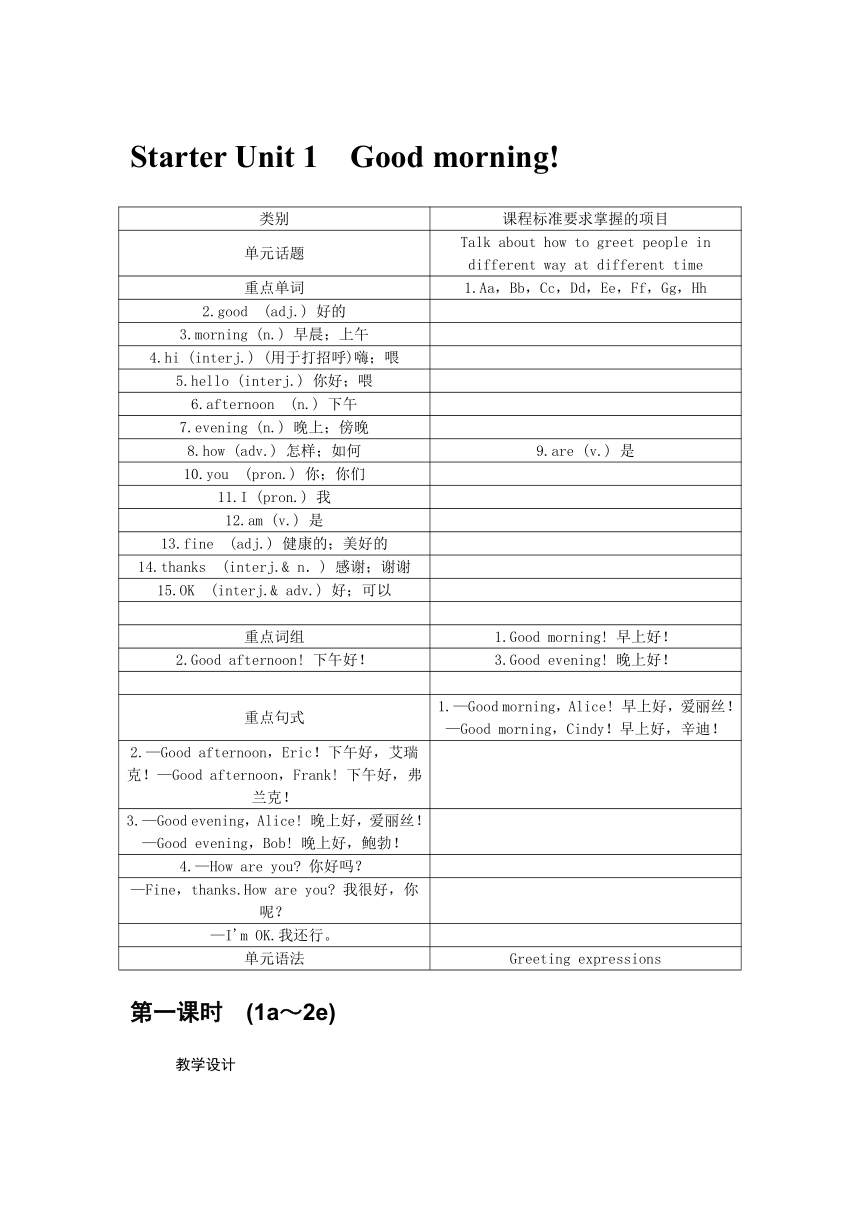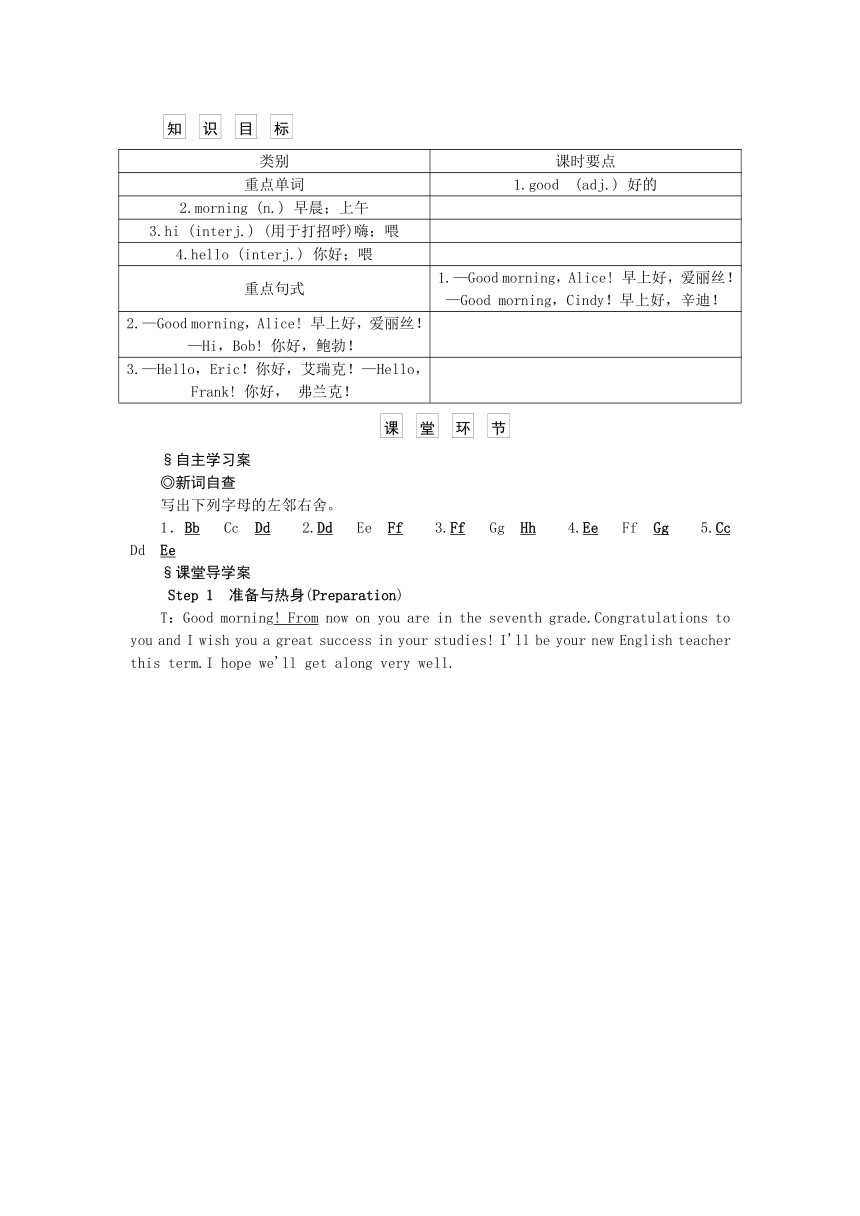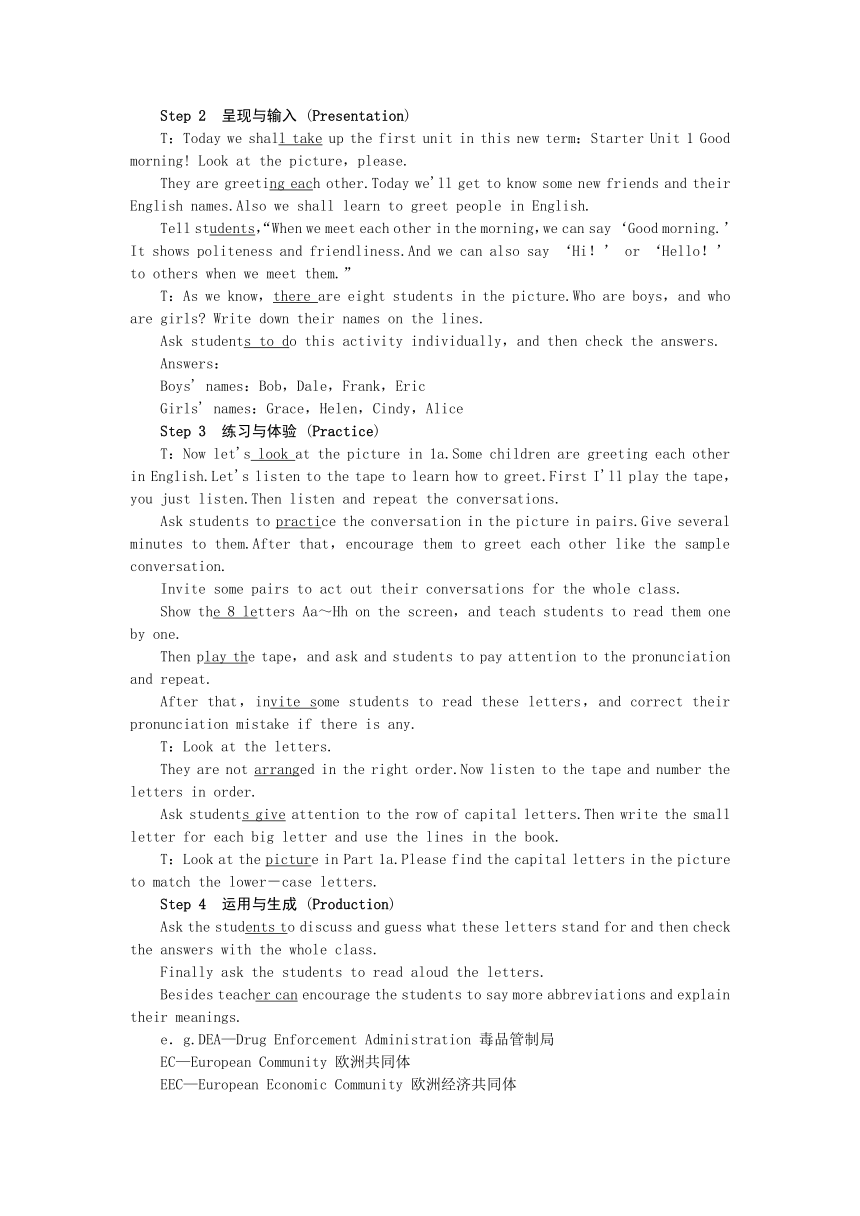人教版七年级英语上册二次备课StarterUnit1 Good morning(共2课时)教学设计含答案
文档属性
| 名称 | 人教版七年级英语上册二次备课StarterUnit1 Good morning(共2课时)教学设计含答案 |  | |
| 格式 | zip | ||
| 文件大小 | 25.4KB | ||
| 资源类型 | 教案 | ||
| 版本资源 | 人教新目标(Go for it)版 | ||
| 科目 | 英语 | ||
| 更新时间 | 2016-09-20 13:25:37 | ||
图片预览



文档简介
Starter
Unit
1 Good
morning!
类别
课程标准要求掌握的项目
单元话题
Talk
about
how
to
greet
people
in
different
way
at
different
time
重点单词
1.Aa,Bb,Cc,Dd,Ee,Ff,Gg,Hh
2.good
(adj.)
好的
3.morning
(n.)
早晨;上午
4.hi
(interj.)
(用于打招呼)嗨;喂
5.hello
(interj.)
你好;喂
6.afternoon
(n.)
下午
7.evening
(n.)
晚上;傍晚
8.how
(adv.)
怎样;如何
9.are
(v.)
是
10.you
(pron.)
你;你们
11.I
(pron.)
我
12.am
(v.)
是
13.fine
(adj.)
健康的;美好的
14.thanks
(interj.&
n.)
感谢;谢谢
15.OK
(interj.&
adv.)
好;可以
重点词组
1.Good
morning!
早上好!
2.Good
afternoon!
下午好!
3.Good
evening!
晚上好!
重点句式
1.—Good
morning,Alice!
早上好,爱丽丝!—Good
morning,Cindy!早上好,辛迪!
2.—Good
afternoon,Eric!下午好,艾瑞克!—Good
afternoon,Frank!
下午好,弗兰克!
3.—Good
evening,Alice!
晚上好,爱丽丝!—Good
evening,Bob!
晚上好,鲍勃!
4.—How
are
you
你好吗?
—Fine,thanks.How
are
you
我很好,你呢?
—I'm
OK.我还行。
单元语法
Greeting
expressions
第一课时 (1a~2e)
类别
课时要点
重点单词
1.good
(adj.)
好的
2.morning
(n.)
早晨;上午
3.hi
(interj.)
(用于打招呼)嗨;喂
4.hello
(interj.)
你好;喂
重点句式
1.—Good
morning,Alice!
早上好,爱丽丝!—Good
morning,Cindy!早上好,辛迪!
2.—Good
morning,Alice!
早上好,爱丽丝!—Hi,Bob!
你好,鲍勃!
3.—Hello,Eric!你好,艾瑞克!—Hello,Frank!
你好,
弗兰克!
§自主学习案
◎新词自查
写出下列字母的左邻右舍。
1.Bb
Cc Dd 2.Dd
Ee Ff 3.Ff
Gg Hh 4.Ee
Ff Gg 5.Cc
Dd Ee
§课堂导学案
Step
1 准备与热身(Preparation)
T:Good
morning!
From
( http: / / www.21cnjy.com )
now
on
you
are
in
the
seventh
grade.Congratulations
to
you
and
I
wish
you
a
great
success
in
your
studies!
I'll
be
your
new
English
teacher
this
term.I
hope
we'll
get
along
very
well.
Step
2 呈现与输入
(Presentation)
T:Today
we
shall
take
( http: / / www.21cnjy.com )
up
the
first
unit
in
this
new
term:Starter
Unit
1
Good
morning!
Look
at
the
picture,please.
They
are
greeting
eac
( http: / / www.21cnjy.com )h
other.Today
we'll
get
to
know
some
new
friends
and
their
English
names.Also
we
shall
learn
to
greet
people
in
English.
Tell
students
( http: / / www.21cnjy.com ),“When
we
meet
each
other
in
the
morning,we
can
say
‘Good
morning.’
It
shows
politeness
and
friendliness.And
we
can
also
say
‘Hi!’
or
‘Hello!’
to
others
when
we
meet
them.”
T:As
we
know,there
( http: / / www.21cnjy.com )are
eight
students
in
the
picture.Who
are
boys,and
who
are
girls
Write
down
their
names
on
the
lines.
Ask
students
to
d
( http: / / www.21cnjy.com )o
this
activity
individually,and
then
check
the
answers.
Answers:
Boys'
names:Bob,Dale,Frank,Eric
Girls'
names:Grace,Helen,Cindy,Alice
Step
3 练习与体验
(Practice)
T:Now
let's
look
( http: / / www.21cnjy.com )at
the
picture
in
1a.Some
children
are
greeting
each
other
in
English.Let's
listen
to
the
tape
to
learn
how
to
greet.First
I'll
play
the
tape,you
just
listen.Then
listen
and
repeat
the
conversations.
Ask
students
to
practi
( http: / / www.21cnjy.com )ce
the
conversation
in
the
picture
in
pairs.Give
several
minutes
to
them.After
that,encourage
them
to
greet
each
other
like
the
sample
conversation.
Invite
some
pairs
to
act
out
their
conversations
for
the
whole
class.
Show
the
8
le
( http: / / www.21cnjy.com )tters
Aa~Hh
on
the
screen,and
teach
students
to
read
them
one
by
one.
Then
play
th
( http: / / www.21cnjy.com )e
tape,and
ask
and
students
to
pay
attention
to
the
pronunciation
and
repeat.
After
that,invite
s
( http: / / www.21cnjy.com )ome
students
to
read
these
letters,and
correct
their
pronunciation
mistake
if
there
is
any.
T:Look
at
the
letters.
They
are
not
arrang
( http: / / www.21cnjy.com )ed
in
the
right
order.Now
listen
to
the
tape
and
number
the
letters
in
order.
Ask
students
give
( http: / / www.21cnjy.com )
attention
to
the
row
of
capital
letters.Then
write
the
small
letter
for
each
big
letter
and
use
the
lines
in
the
book.
T:Look
at
the
pictur
( http: / / www.21cnjy.com )e
in
Part
1a.Please
find
the
capital
letters
in
the
picture
to
match
the
lower-case
letters.
Step
4 运用与生成
(Production)
Ask
the
students
t
( http: / / www.21cnjy.com )o
discuss
and
guess
what
these
letters
stand
for
and
then
check
the
answers
with
the
whole
class.
Finally
ask
the
students
to
read
aloud
the
letters.
Besides
teacher
can
( http: / / www.21cnjy.com )
encourage
the
students
to
say
more
abbreviations
and
explain
their
meanings.
e.g.DEA—Drug
Enforcement
Administration
毒品管制局
EC—European
Community
欧洲共同体
EEC—European
Economic
Community
欧洲经济共同体
EFTA—Economic
Free
Trade
Association
欧洲自由贸易协会
Step
5 巩固与提高(Progress)
【探究点】
Good
morning!
早上好!
此句为正式问候语,用于早晨或上午见面时的相互问候;如果是朋友或熟人则可用Morning。
Good
afternoon!
下午好!
Good
evening!
晚上好!
Good
night!
晚安。
【针对训练】
现在是上午9点,如果你和你朋友约好出去玩,那你们见面时,你应该说__A__
A.Good
morning! B.Good
afternoon! C.Hi.
【探究点】
Hello!
你好!
Hello通常表示熟人打招呼,打电话,或引起对方的注意。也可以说“Hi”。Hello和Hi常用于比较随便的非正式场合。
【针对训练】
Hi,Frank!
(改为同义句)
Hello,Frank!
Step
6 家庭作业(Homework)
1.Practice
the
conversation
in
the
picture
1a,and
try
to
recite
it.
2.Preview
the
next
period.
3.完成学生用书本课时练习。
第二课时 (3a~4d)
类别
课时要点
重点单词
1.afternoon
(n.)
下午
2.evening
(n.)
晚上;傍晚
3.how
(adv.)
怎样;如何
4.are
(v.)
是
5.you
(pron.)
你;你们
6.I
(pron.)
我
7.am
(v.)
是
8.fine
(adj.)
健康的;美好的 9.thanks
(interj.&
n.)
感谢;谢谢
10.OK
(interj.&
adv.)
好;可以
重点句式
1.—Good
afternoon,Eric!下午好,艾瑞克!
—Good
afternoon,Frank!
下午好,弗兰克!
2.—Good
evening,Alice!
晚上好,爱丽丝!
—Good
evening,Bob!
晚上好,鲍勃!
3.—How
are
you
你好吗?
—Fine,thanks.How
are
you
我很好,你呢?
—I'm
OK.我还行。
§自主学习案
◎新词自查
根据汉语提示写单词完成句子。
1.Hello!
I
am
(是)Grace.
2.I'm
OK,thanks
(谢谢).
3.—How
(怎样)are
you
—I'm
fine.
4.Good
afternoon
(下午),Dale!
5.—Good
evening
(晚上),
Cindy.
—Good
evening,Bob.
§课堂导学案
Step
1 准备与热身(Preparation)
T:Good
morning,
( http: / / www.21cnjy.com )boys
and
girls.When
we
meet
our
friends,our
teachers
and
classmates
in
the
morning,we
should
say
“Good
morning”
to
them.But
do
you
know
what
we
should
say
when
we
meet
them
in
the
afternoon
or
in
the
evening
Do
you
know
what
we
also
say
when
we
meet
them
Today
we
will
go
on
learning
to
greet
people.
Step
2 呈现与输入
(Presentation)
Play
the
tape
for
t
( http: / / www.21cnjy.com )he
first
time.The
students
listen
only
and
pay
attention
to
the
pronunciation
and
intonation.
Then
play
the
tape
ag
( http: / / www.21cnjy.com )ain
and
ask
the
students
to
number
the
conversations.Check
the
answers
after
they
finish
it.
Finally
ask
the
students
to
listen
and
repeat.
Step
3 练习与体验
(Practice)
Put
students
i
( http: / / www.21cnjy.com )nto
pairs
to
practice
the
conversations
in
3a.Remind
them
to
pay
attention
to
the
pronunciation
and
intonation.
Leave
them
several
( http: / / www.21cnjy.com )minutes
to
do
it,and
then
invite
some
pairs
to
act
out
for
the
whole
class.
Listen
to
the
conve
( http: / / www.21cnjy.com )rsation
first.Then
repeat
and
practice
the
conversation.
Read
the
tapescript
to
underline
the
useful
sentences.
Then
make
a
new
conversation
in
pairs.
Please
choose
one
of
( http: / / www.21cnjy.com )
these
English
names
for
yourself.Then
write
your
English
name
on
a
card
and
put
it
in
front
of
you
on
the
desk.Greet
each
other.
Step
4 运用与生成
(Production)
Ask
the
students
to
fi
( http: / / www.21cnjy.com )nd
out
the
names
of
the
children
on
page
S1.Then
ask
the
students
to
write
the
names
in
alphabetical
order
and
remind
them
that
the
first
letter
of
the
names
should
be
capitalized.
T:Please
look
at
t
( http: / / www.21cnjy.com )he
letters
and
words
in
the
box.I'll
play
the
recording
for
you
to
listen
and
repeat.Pay
attention
to
the
pronunciation.
After
the
listening
( http: / / www.21cnjy.com ),invite
some
students
to
repeat,checking
their
progress.
Teacher
goes
over
the
pronunciations
of
the
eight
letters.
Ask
the
students
to
( http: / / www.21cnjy.com )read
the
letters
and
names
in
Column
1,and
make
sure
they
know
the
distinction
between
different
pronunciations
of
the
same
letter.
Then
ask
the
stud
( http: / / www.21cnjy.com )ents
to
read
the
new
words
in
Column
2,move
around
and
help
the
students
if
necessary.
Check
their
pronunciation.
Ask
the
students
t
( http: / / www.21cnjy.com )o
look
at
the
new
words
of
this
lesson
and
read.Remind
them
to
pay
attention
to
the
four
vowels:/eI/,/?/,/i?/,/e/.
First,play
the
tape
( http: / / www.21cnjy.com )
of
the
song,asking
students
to
listen
for
the
first
time.
Then
play
it
again,ask
students
to
repeat.
After
that,get
students
to
sing
together.
Give
students
( http: / / www.21cnjy.com )several
minutes
to
practice
singing,and
then
invite
some
students
to
sing
the
song.
Finally,have
a
singing
competition
between
boys
and
girls.
Step
5 巩固与提高(Progress)
【探究点】
—How
are
you
你好吗?
—I'm
fine,thanks.我很好,谢谢。
How
are
you
( http: / / www.21cnjy.com )是熟人、亲戚、朋友间见面时的问候语,用来询问对方的身体状况。回答常用:I'm
fine./Fine./I'm
OK.然后表示感谢。
【拓展】如果第二个人接着问候第一个人的身体
( http: / / www.21cnjy.com )情况时,可以说Fine,thanks.And
you
第一个人回答I'm
fine,too./I'm
OK.
【针对训练】
—__C__?
—Fine,thank
you.
A.How
do
you
do B.Good
morning C.How
are
you
【探究点】
“Thanks.”相当于“Thank
you
( http: / / www.21cnjy.com ).”,是英美人使用频率非常高的一种习惯用语。当对他人的关心、帮助、赞扬或褒奖表示谢意时,常用“Thanks.”或“Thank
you.”来作答。
【针对训练】
—How
are
you
—I'm
fine,__thanks/thank_you__.
Step
6 家庭作业(Homework)
1.Practice
the
conversation
and
recite
it.
2.Preview
the
next
unit.
3.完成学生用书本课时练习。
Unit
1 Good
morning!
类别
课程标准要求掌握的项目
单元话题
Talk
about
how
to
greet
people
in
different
way
at
different
time
重点单词
1.Aa,Bb,Cc,Dd,Ee,Ff,Gg,Hh
2.good
(adj.)
好的
3.morning
(n.)
早晨;上午
4.hi
(interj.)
(用于打招呼)嗨;喂
5.hello
(interj.)
你好;喂
6.afternoon
(n.)
下午
7.evening
(n.)
晚上;傍晚
8.how
(adv.)
怎样;如何
9.are
(v.)
是
10.you
(pron.)
你;你们
11.I
(pron.)
我
12.am
(v.)
是
13.fine
(adj.)
健康的;美好的
14.thanks
(interj.&
n.)
感谢;谢谢
15.OK
(interj.&
adv.)
好;可以
重点词组
1.Good
morning!
早上好!
2.Good
afternoon!
下午好!
3.Good
evening!
晚上好!
重点句式
1.—Good
morning,Alice!
早上好,爱丽丝!—Good
morning,Cindy!早上好,辛迪!
2.—Good
afternoon,Eric!下午好,艾瑞克!—Good
afternoon,Frank!
下午好,弗兰克!
3.—Good
evening,Alice!
晚上好,爱丽丝!—Good
evening,Bob!
晚上好,鲍勃!
4.—How
are
you
你好吗?
—Fine,thanks.How
are
you
我很好,你呢?
—I'm
OK.我还行。
单元语法
Greeting
expressions
第一课时 (1a~2e)
类别
课时要点
重点单词
1.good
(adj.)
好的
2.morning
(n.)
早晨;上午
3.hi
(interj.)
(用于打招呼)嗨;喂
4.hello
(interj.)
你好;喂
重点句式
1.—Good
morning,Alice!
早上好,爱丽丝!—Good
morning,Cindy!早上好,辛迪!
2.—Good
morning,Alice!
早上好,爱丽丝!—Hi,Bob!
你好,鲍勃!
3.—Hello,Eric!你好,艾瑞克!—Hello,Frank!
你好,
弗兰克!
§自主学习案
◎新词自查
写出下列字母的左邻右舍。
1.Bb
Cc Dd 2.Dd
Ee Ff 3.Ff
Gg Hh 4.Ee
Ff Gg 5.Cc
Dd Ee
§课堂导学案
Step
1 准备与热身(Preparation)
T:Good
morning!
From
( http: / / www.21cnjy.com )
now
on
you
are
in
the
seventh
grade.Congratulations
to
you
and
I
wish
you
a
great
success
in
your
studies!
I'll
be
your
new
English
teacher
this
term.I
hope
we'll
get
along
very
well.
Step
2 呈现与输入
(Presentation)
T:Today
we
shall
take
( http: / / www.21cnjy.com )
up
the
first
unit
in
this
new
term:Starter
Unit
1
Good
morning!
Look
at
the
picture,please.
They
are
greeting
eac
( http: / / www.21cnjy.com )h
other.Today
we'll
get
to
know
some
new
friends
and
their
English
names.Also
we
shall
learn
to
greet
people
in
English.
Tell
students
( http: / / www.21cnjy.com ),“When
we
meet
each
other
in
the
morning,we
can
say
‘Good
morning.’
It
shows
politeness
and
friendliness.And
we
can
also
say
‘Hi!’
or
‘Hello!’
to
others
when
we
meet
them.”
T:As
we
know,there
( http: / / www.21cnjy.com )are
eight
students
in
the
picture.Who
are
boys,and
who
are
girls
Write
down
their
names
on
the
lines.
Ask
students
to
d
( http: / / www.21cnjy.com )o
this
activity
individually,and
then
check
the
answers.
Answers:
Boys'
names:Bob,Dale,Frank,Eric
Girls'
names:Grace,Helen,Cindy,Alice
Step
3 练习与体验
(Practice)
T:Now
let's
look
( http: / / www.21cnjy.com )at
the
picture
in
1a.Some
children
are
greeting
each
other
in
English.Let's
listen
to
the
tape
to
learn
how
to
greet.First
I'll
play
the
tape,you
just
listen.Then
listen
and
repeat
the
conversations.
Ask
students
to
practi
( http: / / www.21cnjy.com )ce
the
conversation
in
the
picture
in
pairs.Give
several
minutes
to
them.After
that,encourage
them
to
greet
each
other
like
the
sample
conversation.
Invite
some
pairs
to
act
out
their
conversations
for
the
whole
class.
Show
the
8
le
( http: / / www.21cnjy.com )tters
Aa~Hh
on
the
screen,and
teach
students
to
read
them
one
by
one.
Then
play
th
( http: / / www.21cnjy.com )e
tape,and
ask
and
students
to
pay
attention
to
the
pronunciation
and
repeat.
After
that,invite
s
( http: / / www.21cnjy.com )ome
students
to
read
these
letters,and
correct
their
pronunciation
mistake
if
there
is
any.
T:Look
at
the
letters.
They
are
not
arrang
( http: / / www.21cnjy.com )ed
in
the
right
order.Now
listen
to
the
tape
and
number
the
letters
in
order.
Ask
students
give
( http: / / www.21cnjy.com )
attention
to
the
row
of
capital
letters.Then
write
the
small
letter
for
each
big
letter
and
use
the
lines
in
the
book.
T:Look
at
the
pictur
( http: / / www.21cnjy.com )e
in
Part
1a.Please
find
the
capital
letters
in
the
picture
to
match
the
lower-case
letters.
Step
4 运用与生成
(Production)
Ask
the
students
t
( http: / / www.21cnjy.com )o
discuss
and
guess
what
these
letters
stand
for
and
then
check
the
answers
with
the
whole
class.
Finally
ask
the
students
to
read
aloud
the
letters.
Besides
teacher
can
( http: / / www.21cnjy.com )
encourage
the
students
to
say
more
abbreviations
and
explain
their
meanings.
e.g.DEA—Drug
Enforcement
Administration
毒品管制局
EC—European
Community
欧洲共同体
EEC—European
Economic
Community
欧洲经济共同体
EFTA—Economic
Free
Trade
Association
欧洲自由贸易协会
Step
5 巩固与提高(Progress)
【探究点】
Good
morning!
早上好!
此句为正式问候语,用于早晨或上午见面时的相互问候;如果是朋友或熟人则可用Morning。
Good
afternoon!
下午好!
Good
evening!
晚上好!
Good
night!
晚安。
【针对训练】
现在是上午9点,如果你和你朋友约好出去玩,那你们见面时,你应该说__A__
A.Good
morning! B.Good
afternoon! C.Hi.
【探究点】
Hello!
你好!
Hello通常表示熟人打招呼,打电话,或引起对方的注意。也可以说“Hi”。Hello和Hi常用于比较随便的非正式场合。
【针对训练】
Hi,Frank!
(改为同义句)
Hello,Frank!
Step
6 家庭作业(Homework)
1.Practice
the
conversation
in
the
picture
1a,and
try
to
recite
it.
2.Preview
the
next
period.
3.完成学生用书本课时练习。
第二课时 (3a~4d)
类别
课时要点
重点单词
1.afternoon
(n.)
下午
2.evening
(n.)
晚上;傍晚
3.how
(adv.)
怎样;如何
4.are
(v.)
是
5.you
(pron.)
你;你们
6.I
(pron.)
我
7.am
(v.)
是
8.fine
(adj.)
健康的;美好的 9.thanks
(interj.&
n.)
感谢;谢谢
10.OK
(interj.&
adv.)
好;可以
重点句式
1.—Good
afternoon,Eric!下午好,艾瑞克!
—Good
afternoon,Frank!
下午好,弗兰克!
2.—Good
evening,Alice!
晚上好,爱丽丝!
—Good
evening,Bob!
晚上好,鲍勃!
3.—How
are
you
你好吗?
—Fine,thanks.How
are
you
我很好,你呢?
—I'm
OK.我还行。
§自主学习案
◎新词自查
根据汉语提示写单词完成句子。
1.Hello!
I
am
(是)Grace.
2.I'm
OK,thanks
(谢谢).
3.—How
(怎样)are
you
—I'm
fine.
4.Good
afternoon
(下午),Dale!
5.—Good
evening
(晚上),
Cindy.
—Good
evening,Bob.
§课堂导学案
Step
1 准备与热身(Preparation)
T:Good
morning,
( http: / / www.21cnjy.com )boys
and
girls.When
we
meet
our
friends,our
teachers
and
classmates
in
the
morning,we
should
say
“Good
morning”
to
them.But
do
you
know
what
we
should
say
when
we
meet
them
in
the
afternoon
or
in
the
evening
Do
you
know
what
we
also
say
when
we
meet
them
Today
we
will
go
on
learning
to
greet
people.
Step
2 呈现与输入
(Presentation)
Play
the
tape
for
t
( http: / / www.21cnjy.com )he
first
time.The
students
listen
only
and
pay
attention
to
the
pronunciation
and
intonation.
Then
play
the
tape
ag
( http: / / www.21cnjy.com )ain
and
ask
the
students
to
number
the
conversations.Check
the
answers
after
they
finish
it.
Finally
ask
the
students
to
listen
and
repeat.
Step
3 练习与体验
(Practice)
Put
students
i
( http: / / www.21cnjy.com )nto
pairs
to
practice
the
conversations
in
3a.Remind
them
to
pay
attention
to
the
pronunciation
and
intonation.
Leave
them
several
( http: / / www.21cnjy.com )minutes
to
do
it,and
then
invite
some
pairs
to
act
out
for
the
whole
class.
Listen
to
the
conve
( http: / / www.21cnjy.com )rsation
first.Then
repeat
and
practice
the
conversation.
Read
the
tapescript
to
underline
the
useful
sentences.
Then
make
a
new
conversation
in
pairs.
Please
choose
one
of
( http: / / www.21cnjy.com )
these
English
names
for
yourself.Then
write
your
English
name
on
a
card
and
put
it
in
front
of
you
on
the
desk.Greet
each
other.
Step
4 运用与生成
(Production)
Ask
the
students
to
fi
( http: / / www.21cnjy.com )nd
out
the
names
of
the
children
on
page
S1.Then
ask
the
students
to
write
the
names
in
alphabetical
order
and
remind
them
that
the
first
letter
of
the
names
should
be
capitalized.
T:Please
look
at
t
( http: / / www.21cnjy.com )he
letters
and
words
in
the
box.I'll
play
the
recording
for
you
to
listen
and
repeat.Pay
attention
to
the
pronunciation.
After
the
listening
( http: / / www.21cnjy.com ),invite
some
students
to
repeat,checking
their
progress.
Teacher
goes
over
the
pronunciations
of
the
eight
letters.
Ask
the
students
to
( http: / / www.21cnjy.com )read
the
letters
and
names
in
Column
1,and
make
sure
they
know
the
distinction
between
different
pronunciations
of
the
same
letter.
Then
ask
the
stud
( http: / / www.21cnjy.com )ents
to
read
the
new
words
in
Column
2,move
around
and
help
the
students
if
necessary.
Check
their
pronunciation.
Ask
the
students
t
( http: / / www.21cnjy.com )o
look
at
the
new
words
of
this
lesson
and
read.Remind
them
to
pay
attention
to
the
four
vowels:/eI/,/?/,/i?/,/e/.
First,play
the
tape
( http: / / www.21cnjy.com )
of
the
song,asking
students
to
listen
for
the
first
time.
Then
play
it
again,ask
students
to
repeat.
After
that,get
students
to
sing
together.
Give
students
( http: / / www.21cnjy.com )several
minutes
to
practice
singing,and
then
invite
some
students
to
sing
the
song.
Finally,have
a
singing
competition
between
boys
and
girls.
Step
5 巩固与提高(Progress)
【探究点】
—How
are
you
你好吗?
—I'm
fine,thanks.我很好,谢谢。
How
are
you
( http: / / www.21cnjy.com )是熟人、亲戚、朋友间见面时的问候语,用来询问对方的身体状况。回答常用:I'm
fine./Fine./I'm
OK.然后表示感谢。
【拓展】如果第二个人接着问候第一个人的身体
( http: / / www.21cnjy.com )情况时,可以说Fine,thanks.And
you
第一个人回答I'm
fine,too./I'm
OK.
【针对训练】
—__C__?
—Fine,thank
you.
A.How
do
you
do B.Good
morning C.How
are
you
【探究点】
“Thanks.”相当于“Thank
you
( http: / / www.21cnjy.com ).”,是英美人使用频率非常高的一种习惯用语。当对他人的关心、帮助、赞扬或褒奖表示谢意时,常用“Thanks.”或“Thank
you.”来作答。
【针对训练】
—How
are
you
—I'm
fine,__thanks/thank_you__.
Step
6 家庭作业(Homework)
1.Practice
the
conversation
and
recite
it.
2.Preview
the
next
unit.
3.完成学生用书本课时练习。
同课章节目录
- starters 预备篇(2012秋审查)
- Unit 1 Good morning !
- Unit 2 What’s this in English?
- Unit 3 What color is it ?
- Unit 1 My name's Gina.
- Section A
- Section B
- Unit 2 This is my sister.
- Section A
- Section B
- Unit 3 Is this your pencil?
- Section A
- Section B
- Unit 4 Where's my schoolbag?
- Section A
- Section B
- Unit 5 Do you have a soccer ball?
- Section A
- Section B
- Unit 6 Do you like bananas?
- Section A
- Section B
- Unit 7 How much are these socks?
- Section A
- Section B
- Unit 8 When is your birthday?
- Section A
- Section B
- Unit 9 My favorite subject is science.
- Section A
- Section B
